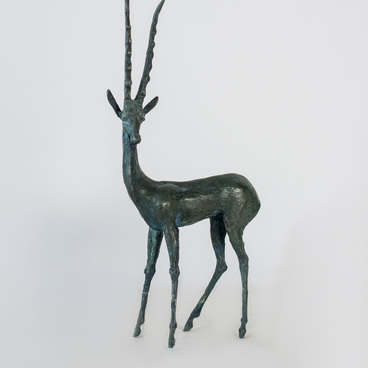The painting “Family” from the collection of the Volzhsk Art Gallery was painted by artist Igor Timchenko in 1987. He depicted two women with a small child.
On the left sits, there is a woman, holding her grandson in her arms. Her brown hair, still not touched by age, is made in a strict bun, her shoulders are covered with a thick dark shawl with tassels. A dark blue skirt reveals the knees.
A young woman with her hair let down — the child’s mother — stands on the right. She looks at the baby, ready to pick him up. The girl wears a red summer dress with open shoulders, the outfit is completed with a kerchief of light translucent fabric. Both women give their whole attention to the baby, while it looks directly at the viewer.
In the background, Timchenko depicted a tranquil landscape with a river. The painting is performed in a pale lilac color scheme with tempera paints on canvas.
Before oil paints gained popularity in Europe in the 15th century, tempera colors remained the main ones in easel painting. Many icons were painted in tempera on a wooden base primed with white levkas.
Tempera paints are prepared on a water base mixed with pigment. In the past, natural emulsions — an egg yolk or a whole egg mixed with water — were used as a binder medium. Later emulsions of casein glue and vegetable oil were used, and some modern tempera paints are made with polymers, such as PVA glue. These paints can be used while working in both the impasto technique by applying thick, voluminous layers, and the glazing technique with its thin, translucent strokes. The surface of a tempera painting becomes velvety and matte and takes a long time to dry.
In Russia, the technique of tempera painting was predominant in art until the late 17th century.
The three characters in the painting by Igor Timchenko are an allegory of the three life stages — childhood, youth and adulthood — that naturally follow one another. The idea of changing these stages, similar to the change of seasons, has been long popular in art. There are many paintings on this subject, such as Titian’s “The Three Ages of Man”, Hans Baldung’s “The Three Ages of Woman and Death”, Edvard Munch’s “Woman in Three Stages”, Gustav Klimt’s “The Three Ages of Woman”, Salvador Dali’s “The Three Ages”, and others.
On the left sits, there is a woman, holding her grandson in her arms. Her brown hair, still not touched by age, is made in a strict bun, her shoulders are covered with a thick dark shawl with tassels. A dark blue skirt reveals the knees.
A young woman with her hair let down — the child’s mother — stands on the right. She looks at the baby, ready to pick him up. The girl wears a red summer dress with open shoulders, the outfit is completed with a kerchief of light translucent fabric. Both women give their whole attention to the baby, while it looks directly at the viewer.
In the background, Timchenko depicted a tranquil landscape with a river. The painting is performed in a pale lilac color scheme with tempera paints on canvas.
Before oil paints gained popularity in Europe in the 15th century, tempera colors remained the main ones in easel painting. Many icons were painted in tempera on a wooden base primed with white levkas.
Tempera paints are prepared on a water base mixed with pigment. In the past, natural emulsions — an egg yolk or a whole egg mixed with water — were used as a binder medium. Later emulsions of casein glue and vegetable oil were used, and some modern tempera paints are made with polymers, such as PVA glue. These paints can be used while working in both the impasto technique by applying thick, voluminous layers, and the glazing technique with its thin, translucent strokes. The surface of a tempera painting becomes velvety and matte and takes a long time to dry.
In Russia, the technique of tempera painting was predominant in art until the late 17th century.
The three characters in the painting by Igor Timchenko are an allegory of the three life stages — childhood, youth and adulthood — that naturally follow one another. The idea of changing these stages, similar to the change of seasons, has been long popular in art. There are many paintings on this subject, such as Titian’s “The Three Ages of Man”, Hans Baldung’s “The Three Ages of Woman and Death”, Edvard Munch’s “Woman in Three Stages”, Gustav Klimt’s “The Three Ages of Woman”, Salvador Dali’s “The Three Ages”, and others.



